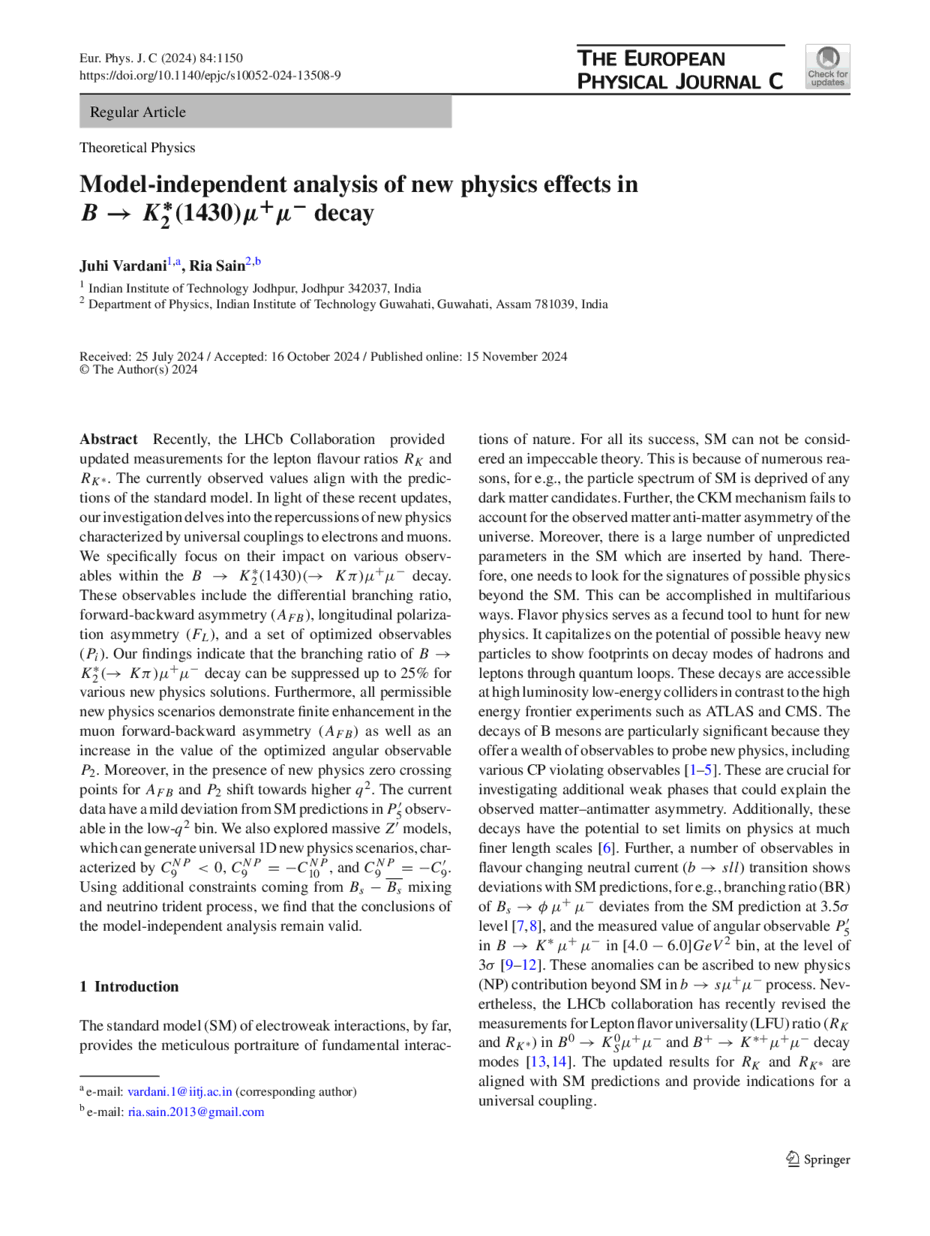https://doi.org/10.1140/epjc/s10052-024-13508-9
Regular Article
Model-independent analysis of new physics effects in  decay
decay
1
Indian Institute of Technology Jodhpur, 342037, Jodhpur, India
2
Department of Physics, Indian Institute of Technology Guwahati, 781039, Guwahati, Assam, India
Received:
25
July
2024
Accepted:
16
October
2024
Published online:
15
November
2024
Recently, the LHCb Collaboration provided updated measurements for the lepton flavour ratios  and
and  . The currently observed values align with the predictions of the standard model. In light of these recent updates, our investigation delves into the repercussions of new physics characterized by universal couplings to electrons and muons. We specifically focus on their impact on various observables within the
. The currently observed values align with the predictions of the standard model. In light of these recent updates, our investigation delves into the repercussions of new physics characterized by universal couplings to electrons and muons. We specifically focus on their impact on various observables within the  decay. These observables include the differential branching ratio, forward-backward asymmetry (
decay. These observables include the differential branching ratio, forward-backward asymmetry ( ), longitudinal polarization asymmetry (
), longitudinal polarization asymmetry ( ), and a set of optimized observables (
), and a set of optimized observables ( ). Our findings indicate that the branching ratio of
). Our findings indicate that the branching ratio of  decay can be suppressed up to
decay can be suppressed up to  for various new physics solutions. Furthermore, all permissible new physics scenarios demonstrate finite enhancement in the muon forward-backward asymmetry
for various new physics solutions. Furthermore, all permissible new physics scenarios demonstrate finite enhancement in the muon forward-backward asymmetry  as well as an increase in the value of the optimized angular observable
as well as an increase in the value of the optimized angular observable  . Moreover, in the presence of new physics zero crossing points for
. Moreover, in the presence of new physics zero crossing points for  and
and  shift towards higher
shift towards higher  . The current data have a mild deviation from SM predictions in
. The current data have a mild deviation from SM predictions in  observable in the low-
observable in the low- bin. We also explored massive
bin. We also explored massive  models, which can generate universal 1D new physics scenarios, characterized by
models, which can generate universal 1D new physics scenarios, characterized by  ,
,  , and
, and  . Using additional constraints coming from
. Using additional constraints coming from  mixing and neutrino trident process, we find that the conclusions of the model-independent analysis remain valid.
mixing and neutrino trident process, we find that the conclusions of the model-independent analysis remain valid.
© The Author(s) 2024
 Open Access This article is licensed under a Creative Commons Attribution 4.0 International License, which permits use, sharing, adaptation, distribution and reproduction in any medium or format, as long as you give appropriate credit to the original author(s) and the source, provide a link to the Creative Commons licence, and indicate if changes were made. The images or other third party material in this article are included in the article’s Creative Commons licence, unless indicated otherwise in a credit line to the material. If material is not included in the article’s Creative Commons licence and your intended use is not permitted by statutory regulation or exceeds the permitted use, you will need to obtain permission directly from the copyright holder. To view a copy of this licence, visit http://creativecommons.org/licenses/by/4.0/.
Open Access This article is licensed under a Creative Commons Attribution 4.0 International License, which permits use, sharing, adaptation, distribution and reproduction in any medium or format, as long as you give appropriate credit to the original author(s) and the source, provide a link to the Creative Commons licence, and indicate if changes were made. The images or other third party material in this article are included in the article’s Creative Commons licence, unless indicated otherwise in a credit line to the material. If material is not included in the article’s Creative Commons licence and your intended use is not permitted by statutory regulation or exceeds the permitted use, you will need to obtain permission directly from the copyright holder. To view a copy of this licence, visit http://creativecommons.org/licenses/by/4.0/.
Funded by SCOAP3.





